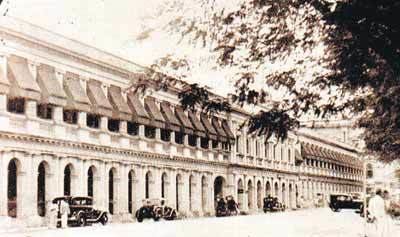Disbanded 2 October 1971 Seats 30 | Established 1947 Succeeded by None | |
 | ||
Preceded by State Council of Ceylon | ||
The Senate was the upper chamber of the parliament of Ceylon (now Sri Lanka) established in 1947 by the Soulbury Commission. The Senate was appointed/indirectly elected rather than directly elected. The Senate was housed in the old Legislative Council building in Colombo Fort and met for the first time on 12 November 1947. The Senate was abolished on 2 October 1971 by the eighth amendment to the Soulbury Constitution, prior to the adoption of the new Republican Constitution of Sri Lanka on 22 May 1972. In 2010 there were proposals to reintroduce the Senate.
Contents
Creation
With the recommendations of the Soulbury Commission, the Senate of Ceylon was established in 1947 as the upper house of Parliament of Ceylon. The Senate was modelled on the House of Lords in the United Kingdom. It was a thirty-member Senate where the members where appointed rather than elected. One of its fundamental aims was to act as a revising chamber by scrutinizing or amending bills, which had been passed by the House of Representatives. This was intended to act as a stopgap barrier to prevent the government in power trying to rush through important legislations without giving adequate time to consider such legislations.
Abolition
The leftist parties of Ceylon and other republicans considered the Senate, with half its members being appointed by the British monarch's representative - the Governor General, to be one of the last vestiges of colonial rule. The Senate had also been dominated by the United National Party since its creation. Soon after United Front, an alliance consisting of the Sri Lanka Freedom Party, main opposition party, and the leftist parties came to power at the May 1970 election it brought in a parliamentary bill to abolish the Senate. The bill's second reading was passed by the House of Representatives on 21 May 1971. The Senate met for the last time on 28 September 1971. The Ceylon (Constitution and Independence) Amendment Act, No. 36 of 1971 received Royal Assent on 2 October 1971, becoming the eighth amendment to the Soulbury Constitution. The Senate was abolished in 1971 after nearly 24 years of existence. A unicameral parliamentary system was introduced with the adaptation of the Republican Constitution of Sri Lanka in 1972.
Recent developments
Recently there have been consideration into the reintroduction of a senate into the Parliament of Sri Lanka. The United People's Freedom Alliance Government, led by Mahinda Rajapaksa, is exploring possibilities to change the existing parliamentary system significantly. The government proposes that the new Senate will have around 45% of the members from the Parliament and the remaining 55% to be appointed by the President taking the recommendations of the religious leaders and other distinguished personalities of the Civil Society. Therefore, the proposed Senate will have a total of 65 Members, 28 Sinhalese and the rest, 37, would be appointed from minority communities, professionals and other intellectuals.
Role
The Senate was intended to act as a revising chamber, scrutinizing and amending bills which had been passed by the House of Representatives. The model for the Senate's role was the House of Lords in the United Kingdom.
All Parliamentary Bills other than Money (finance) Bills could originate in the Senate. The Senate couldn't reject or amend or delay beyond one month a Money Bill. If any other Bill, that had been passed twice by the House of Representatives, is rejected by the Senate twice it was deemed to have been passed by both chambers.
Membership
The Senate consisted of 30 members. 15 member were elected by the lower chamber, the House of Representatives, using the proportional representation system, each MP having a single transferable vote. The other 15 members were appointed by the Governor-General of Ceylon on advice of the Prime Minister and generally consisted of distinguished individuals. The Senators were known as "Elected Senators" and "Appointed Senators" respectively.
The minimum age for membership of the Senate was 35 and members of the House of Representatives weren't allowed to be members of the Senate. At least two government ministers had to be Senators. No more than two Senators could be Parliamentary Secretaries (deputy ministers).
The normal term of office of a Senator was six years. One third of the Senate (five elected and five appointed) retired every two years. Retiring Senators were eligible for re-election or re-appointment. If a Senator resigned, died or was otherwise removed from office, their replacement, elected or appointed, would serve the remainder of their term of office.
